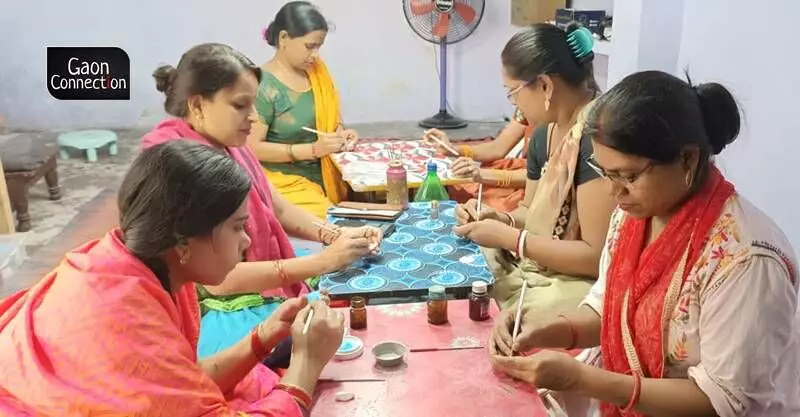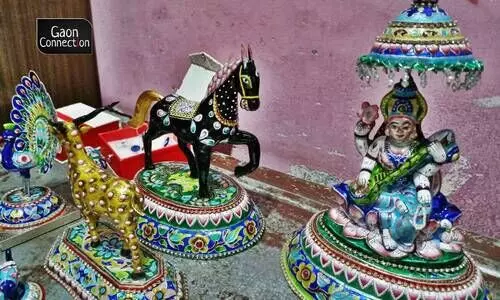Varanasi, Uttar Pradesh
Somewhere in the narrow lanes of Gai Ghat in Varanasi, lives Kunj Bihari Singh, a custodian of an old art form, Gulabi Meenakari (pink enamelwork). The 43-year-old craftsman is a national award winner in Gulabi Meenakari and he has travelled to many countries to exhibit and speak about the art form.
Said to have originated in Persia and brought to the Indian subcontinent by the Mughals, the enamel and precious metal art holds a GI (geographical indication) tag that it got in 2015.
“The art (Gulabi Meenakari) might have come from Persia, but the people of Banaras (Varanasi) have made it their own and made it famous,” the craftsman said.
The enamel work adorned the crowns and thrones of royalty and the Mughals brought it to Varanasi and it has been practised there ever since. At one time receptacles and ornaments in gold and silver were embellished in minakari with figures of elephants, horses, peacocks, etc. Now, figurines of Indian Gods proudly bear gorgeous meenakari work in bright blues, greens, yellows and red.

Gulabi Meenakari work has turned out to be a source of income to more than 200 women in the city.
Also Read: Chiteri art of Bundelkhand gets a brush up
Meenakari work has been a source of livelihood for many people in the holy city of Varanasi on the banks of the Ganges. It involves colouring the surface of metals with a fusion of colours, in which pink is prominent, and hence the name Gulabi Meenakari.
However, like it has been with so many handicrafts and art forms in the country, the number of artisans skilled in Gulabi Meenakari began to dwindle. The craft almost disappeared between 2007 and 2014, as there was no government support for the artisans.
“Before that, there were more than 250 people associated with this craft in Banaras. But after that. there were barely 30 or 40 people left, who still practised this art form,” said Kunj Bihari who learnt the craft from his mother, Leela Devi. “Now, the numbers are increasing and there are nearly 400 artisans in Banaras doing Gulabi Meenakari of which more than 200 are women,” Kunj Bihari told Gaon Connection.
“When the price of gold and silver shot up, many artisans decided they could make more money opening paan shops or driving around autos,” the national awardee said. “I too faced bad times and in 2012-13, had almost decided to buy myself an auto. But, I don’t know what it was that stopped me from doing that. I am happy I changed my mind as I am now recognised as an artist and not an auto driver,” Kunj Bihari smiled. He informed that gulabi meenakari artefacts are priced between Rs 1,000 and many lakhs.
The central and state governments have been focusing on promoting regional arts and crafts by providing traditional artisans platforms where they can show their craft, through exhibitions, demos, etc. “In the last eight years, I have travelled to Saudi Arabia, Dubai and Geneva, with support of the government, to showcase my work,” he said.
Kunj Bihari points out with pride how last month, during the G7 meet in Germany, Prime Minister Narendra Modi gifted Joe Biden, the president of the United States of America, a pair of cufflinks, and the American First Lady Jill Biden, a peacock brooch both handcrafted with Gulabi Meenakari work.
“In the past few years, the government has encouraged the artisans to showcase their work in several exhibitions both within and outside the country,” Kunj Bihari said, adding that that kind of support went a long way in encouraging former artisans who had moved over to other jobs, to reconsider coming back to minakari work again.
Also Read: A handful of artistes strive to revive the centuries old Paitkar art from Jharkhand
Gulabi Meenakari
The nearly 400-odd-year-old art of Gulabi Meenakari that has its origins in Persia involves engraving precious metals such as gold and silver after which the colours are filled in. It is complicated and involves strict adherence to the several steps that bring out the right results.
The colours, in order to be set properly, need to be subject to high temperatures. Too low or too high can ruin the work. The base colour is white over which the paintings are made in other bright colours that are first mixed in sandalwood oil.
There are several kinds of meenakari work in the country. The Ek Rang Khula Meena is a form where only one transparent colour is used and outlined in gold; the Panch Rangi Meena, which as its name suggests, uses five colours of red, white, green, light blue and dark blue; and finally the Gulabi Meenakari of Varanasi that gets its name from the colour pink which is prominently used.
Women artisans
Gulabi Meenakari work has turned out to be a source of income to more than 200 women in the city. Once a male dominated art form, today women work at this for three to four hours a day at home itself and earn a decent income, the national awardee said. He himself has about 50 women working alongside him.
“I learnt this art form and ever since I earn about Rs 18,000 to Rs 20,000 a month,” Chandni Yadav, a Master of Commerce (M Com) student told Gaon Connection. She has learnt this art and been practising it for five years, and now also teaching others, she said.
Chandni had dreamed of becoming a fashion designer but she said that gulabi meenakari gave her the same sense of accomplishment. She has had the opportunity of displaying her work to state Chief Minister Adityanath Yogi and the Union minister Smriti Irani.
Another national award winner Tarun Kumar Singh, through a CSR initiative of a private firm, is training women in the craft. “About fifteen women who come to train, work for about three to four hours a day and earn about four thousand rupees a month, as they learn,” he told Gaon Connection.
“I learnt the gulabi meenakari work here. I enjoy it and I also earn some money,” Meenu Singh, who is learning the craft under Tarun Kumar Singh, told Gaon Connection. The craftsman said there were discussions to increase the stipend for the women.
Arundhati, a student of National Institute of Design, Ahmedabad (Gujarat) was so enamoured by the gulabi meenakari work that she was carrying back artefacts worth Rs 10,000 with her, earlier this month.




















